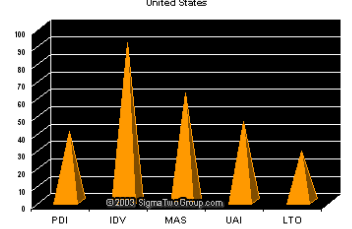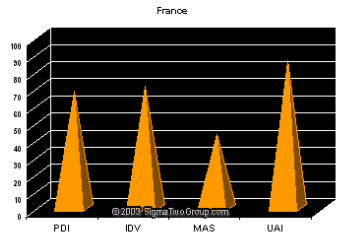Introduction
Globalization is scaling down the earlier barriers that existed to carry out business in other countries. Today, there is a lot of international interaction in doing business, for instance, there are many USA citizens and companies transacting business in Europe, Asia, Africa and Middle East.
At one time, the conviction among many companies was that only one approach of business could be used all over the world and lead to effectiveness and efficiency (Miltenburg, 2005). As internationalization crippled in, it dawned on many of the companies that it was becoming impossible to transact business in similar manner almost in all countries.
The discovery made by superior companies was that in order to succeed in international business, there was an inevitable need to recognize that strategies and practices used must reflect the culture of each country in which they operate (Miltenburg 2005).
Such reality befell Euro Disneyland Company, a USA company that operates in France. The clearest point in the case of Euro Disneyland is that international companies have no ability to manage their dispersed facilities with ‘one-size-fits-all’ practices (Miltenburg 2005).
Culture and customer needs do not appear to be the same across countries a fact that require companies to adequately understand the role and impact of culture on behavior before they can design their strategies and practices for each country.
Therefore, analyzing Euro Disneyland, this research paper will investigate cultural dimension and differences between USA and France, using Trompenaars’ research, how these differences can be explained, the shortcomings the company made in France and lastly, key educative lessons that Euro Disneyland would have learnt on how to go about the issue of diversity.
Cultural dimensions according to Hofstede’s: USA and France analysis
Geert Hofstede asserted that there was no one particular method of management that could be used across all cultures. Further, management as a concept cannot be isolated from other aspects of the society such as school, family, politics, and even religion. As such, effective understanding of management concept, Hofstede advises that managers and companies need knowledge and empathy of the local scene.
The author defines organization’s culture as, “the collective programming of the mind, which characterizes the members of one organization from others” (Grabot, Mayere and Bazet, 2008, p.184). At the same time, national culture can be defined as, “the collective programming of the mind which distinguishes the members in one human group from another” (Grabot, Mayere and Bazet, 2008, p.184).
Hofstede carried a far-reaching research of different national cultures incorporating more than 70 countries, and in the year 2001, Hofstede using data he had collected designed which constituted four key dimensions that characterize different cultured.. The four dimensions are “Power Distance, Uncertainty Avoidance, Masculinity, and Individualism” (Grabot, Mayere and Bazet 2008, p.184).
Power Distance Index (PDI)
In general the dimensions pays attention to beliefs different people hold concerning equality and inequality in terms of distribution of power and status and the way people in particular society accept inequality (Nelson, 2010, p.1). Countries that exhibit high power distance, individual in power have considerable power and their decisions are not in any way challenged easily.
On the other hand, individuals in low power distance societies have high expectation to be involved in key processes of decision making where at the same time they have low regard to centralized power (Grabot, Mayere and Bazet 2008).
Masculinity (MAS)
Masculinity largely manifests itself in communities that have clearly separated and defined gender roles and in such communities much emphasis on values like insolence and economic power. On the other hand, societies that are appear to be feminine in nature favor values such as modesty, tenderness, and quality of life. In masculine societies, stricter task orientation is always favored and promoted (Hofstede, n.d, p.1).
Individualism (IDV)
This dimension concludes that nations are either labeled ‘individualist’ or ‘collectivistic’ and according to Hofstede, loose ties among the people characterize individualistic societies, and people are largely ‘for themselves’ and thinking terms of ‘me’.
On contrary, collectivistic societies’ individuals immediately when they are born become intertwined in the well-built solid in-groups, where loyalty to the group lasts a lifetime and individuals think and act in terms of ‘we’ (Hofstede, n.d, p.1).
Uncertainty Avoidance Index (UAI)
The position of Hofstede is that there are varied extent in different communities as to how members of those communities feel not secure as a result of the presented uncertain or undefined circumstances (Grabot, Mayere and Bazet 2008, p.184). In essence, it involves search for truth specifically in unstructured situations.
Different cultures program their members differently in terms of being comfortable or uncomfortable during uncertainty periods. In addition, cultures that greatly avoid uncertainty will be involved in anything that intends to reduce the occurrence of such possibilities.
However, in cultures that manifest less uncertainty appear to have and express greater trust and confidence in new ventures and always they express enthusiasm to embrace and apply innovative things (Hofstede, n.d, p.1).
Hofstede Score for USA

Hofstede Score for France

Source: Hofstede n.d
Analyzing the Scores in terms of PDI, France rates higher (68) than USA (40). On IDV USA exceeds France, where USA has (88) while France has (67).
When MAS is compared it is evident USA outperforms France with statistics being 58 for USA and 37 for France. Lastly, UAI USA performs distantly behind France with statistics showing 42 for USA and 80 for France (Hofstede n.d, p.1).
Trompenaars’ research on organizational culture: USA and France
Trompenaars and Hampden-Turner did a research in 30 countries and their main concentration was on employees where they envisaged to find out how businesses operated and which particular problems were pertinent in a range of cultural settings (Cahill 2007).
The results were published in their famous book, “Riding the Waves of Culture” (Smirnova, 2007, p.1) in 1997 and the authors discussed seven key dimensions which were identified during the research.
The validated seven proportions that describe how cultural differences takes place occur include, “universalism vs. particularism, individualism vs. communitarism, affective vs. neutral, specific vs. diffuse, achievement vs. ascription, attitude to time and attitudes to the environment” (Smirnova, 2007, p.1).
“Universalism vs. particularism” largely postulates how individual react to rule obedience where those who believe in universal principles adhere to universally agreed standards while particularists’ main focal point is on the exceptional characteristic of current circumstance (Trompenaars and Hampden-Turner, 1997 cited in Cahill 2007).
When compared, USA appears to favor universalism rules than France. “Individualism vs. communitarianism” element explores the association that exist between people and different groups that are found in the larger community whereby some societies promote self-interest (individualism) while others are more concerned with overall community goals and objectives as their first priority (Cahill, 2007).
According to this, USA is seen to be largely individualist while France is seen to favor collectivism or communitarianism (Smirnova, 2007, p.1).
With regard to affective vs. neutral, it observed that some cultures have a high likelihood of expressing their emotions more than what members of other cultures will do while neutral societies approach is largely indirect. USA is more neutral than France, which appears to be affective, but the degree of difference is low (Cahill 2007).
On the specific vs. diffuse dimension, the concentration is on how members of the community engage in forming relationships among themselves for instance to what degree are members close to each other in the cycles of their lives and how diffusely the relation formed may be or has existed.
USA and France seem to be specific but in some instances, manifestation of a degree of difference is inevitable between the two countries. Achievement vs. Ascription dimension postulates that individuals are assigned status depending on how well they carry out their roles (achievement) or status is given depending on who or the individual is (ascription) in the society (Smirnova 2007, p.1).
Although both USA and France manifest cultures where status is given based on achievement, there exists considerable gaps. With respect to attitudes and time, some societies put more emphasis on past or are present-oriented where they focus on history and tradition of the specific culture.
On the other hand, other societies are future-oriented where they put more emphasis on opportunities that are likely to come from an agreement. Moreover, USA tends to be future-oriented while France tend to be past or present-oriented (Smirnova 2007, p.1). Regarding attitude to environment, USA tends to be self-determined as compared to France.
Mistakes Euro Disneyland made
Upon signing agreement with France government, Euro Disneyland pooled resources to put up one of the classic structure described as the ‘deal of century’ (Luthans and Doh, 2009). However, unfortunately as its operations started, the organization made three mistakes, generally described as ‘cultural mistakes’.
First, the organization did not involve the people of France in its decision-making processes prompting wide protests that opposed the company on what they termed as America’s cultural imperialism (Luthans and Doh, 2009).
In addition, prior to its construction, the organization put up its current infrastructure in a region the farmers heavily occupied, and hence many experience location forcing them to loose their long-time attachment to their land. Euro Disney lacked any cultural mechanism that it could use to reduce anger and remorsefulness among these people.
In the end, Euro Disney appeared in the eyes of many people as a foreign entity with a mission to promote America’s ‘neoprovincialism’; hence, people became largely detached to Euro Disneyland (Luthans and Doh, 2009).
Moreover, the aspect of Euro Disney appointing American-born managers did not go down well with many French since they did not have any grasp of French language. Lastly, nothing angered the French public than Euro Disneyland’s strict code of appearance.
Lessons the Company would have learnt about Diversity
First, during its first year of operation in France, Euro Disneyland paid little attention on the culture aspects and requirement of people of France. The organization’ management largely ‘imported’ ideas and management styles, which were believed to be able to work and succeed in France. The organization was supposed to have recognized and adapted France’s cultural dimension of low masculinity and embraced other aspects.
Conclusion
Cultural awareness is important especially for companies and organizations working in foreign environment. The belief that one management style can successfully work in another environment has contributed to failure of many organizations specifically when cultures clash.
Therefore, what is important is for managers to carry out an assessment of the foreign cultural environment accurately by understanding the existent of differences in values and norms between the two countries and how such behavior differences could lead to varying forms of behavior and actions (Ralston, Terpstra, Cunniff and Gustafson, n.d).
Reference List
Cahill, D. L., 2007. Customer loyalty in third party logistics relationships: findings from studies in Germany and the USA. NY, Springer. Web.
Grabot, B., Mayere, A., and, Bazet, I., 2008. ERP systems and organizational change: a socio-technical insight. UK, Springer. Web.
Hofstede, G., Cultural Dimension. Web.
Luthans, F. and Doe, J. P., 2009. International Management: Culture, Strategy and Behavior. (Attached notes).
Miltenburg, J., 2005. Manufacturing strategy: how to formulate and implement a winning plan. NY, Productivity Press. Web.
Nelson, L., 2010. Hofstede’s Cultural Dimensions: Decoded. Web.
Ralston, D. A., Terpstra, R. H., Cunniff, M. K. and Gustafson, D. J., Do Expatriates change their behavior to fit a foreign culture? A study of American Expatriates’ strategies of upward influence. Web.
Smirnova, L., 2007. The Practical Guide to Culture in the Workplace-Fons Trompenaars (1993). Web.